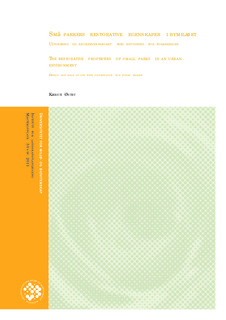| dc.description.abstract | Oppfatningen om at naturen har god innvirkning på menneskets helse har vært kjent langt tilbake i historien. I denne masteroppgaven har jeg valgt å fokusere på hvilke parkkomponenter og aktiviteter som oppleves som restorative for mennesker som lever, jobber og studerer i en storby som Oslo. For å få svar på dette har jeg brukt studenter ved Høgskolen i Oslo. Deltakerne ble presentert for bilder av små urbane parker i Skandinavia, og beskrev med egne ord hva som opplevdes som restorativt i parkbildene, og hvilke aktiviteter de foretrakk å gjøre i slike parker. Resultatene av studien viser at det er flere faktorer i miljøet som spiller inn for at folk skal oppleve små urbane parker som restorative. Omgivelsene og atmosfæren i og rundt parkene, opplevdes som nesten like viktig som parkkomponentene og designen i parkene. Parkkomponentene deltakerne mente bidro til mest restorative opplevelser var gress, blomster og planter, vannelementer, busker og trær og skjermete/ lukkede rom. De komponentene som bidro til at miljøet i parkbildene ikke opplevdes som restorative, var mye harde flater, dårlig skjerming, lite gress, manglende vedlikehold og få og ukomfortable benker. I omgivelsene og atmosfæren rundt parkene opplevdes mye trafikk, mange bygninger, mye folk og støy som minst restorativt, mens rolig atmosfære i parkene opplevdes som mest restorativt. Denne kunnskapen kan være nyttig ved fremtidig samfunns- og arealplanlegging i forbindelse med økt befolkningsvekst og fortetting i Oslo, så det kan tilrettelegges for å bevare grøntområder med intensjon om å redusere stress og mental utmattelse, og for å fremme den generelle folkehelsen. I forhold til ønskede aktiviteter i små urbane parker, viser resultatene i studien at ro og hvile både på det psykiske, sosiale og fysiske plan, foretrekkes. Dette indikerer at det ikke er behov for så stor plass for å oppnå restitusjon, men at antall små urbane parker vil være vel så viktig i årene som kommer.
Abstract:
The notion that nature has a good influence on human health has been with us since far back in history. In this Master’s thesis I have chosen to focus on which park components and activities that are perceived as restorative by the people who live, work, and study in a big city like Oslo. Students from Oslo University College have been my informants when trying to answer this question. The informants were presented with pictures of small urban parks in Scandinavia, and then they described in their own words what they found restorative about the park pictures and what kind of activities they preferred to be doing in such parks. The results of the study show that there are several factors in the environment that all play a role in people experiencing small urban parks as restorative. The surroundings and the atmosphere around the parks were experienced as almost as important as the park’s components and design. The park components perceived as adding the most to a restorative experience were grass, flowers and plants, water elements, bushes and trees and shielded/enclosed areas. The components contributing to the environment in the park pictures being experienced as non-restorative were lots of hard surfaces, poor shielding, little grass, poor maintenance, and few and uncomfortable benches. In the environment and atmosphere around the parks a lot of traffic, many buildings, and a lot of people and noise were experienced as least restorative while a calm atmosphere in the parks was experienced as the most restorative. This knowledge can be of use in future community and area planning in connection with an increase in population growth and density in Oslo. In this way one can plan to preserve green areas with the intention of reducing stress and mental exhaustion, and to promote public health in general. In relation to desired activities in small urban parks, the study shows that peace and rest both mentally, socially and physically are preferred. This indicates that there is no need for a large area to achieve restitution but rather that the number of small urban parks will be just as important in the years to come. | en_US |
